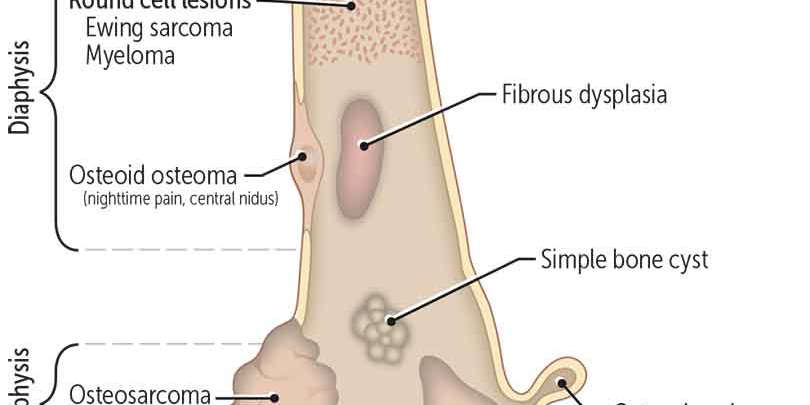Primary Bone Tumors


A neoplasm is the abnormal growth of new cells, sometimes called a tumor. A variety of tumors can grow in our bones, and luckily more of them are benign (noncancerous) than malignant (cancerous). What causes these tumors? We usually don’t know, though we do know that most malignant bone tumors are secondary, with cancer spreading to the bones from other organs, including the nearby bone marrow. Malignant primary bone tumors (those that start in the bone) are thankfully rare but still are the sixth most common cancer in children and third most common in adolescents. In the United States, about 3000 cases of malignant bone tumors are diagnosed each year and about half of these cases result in death.
The terminology of these tumors overlaps quite a bit and can be confusing. We usually equate the prefix sarco- with muscle (sarcomere, sarcolemma, sarcoplasmic reticulum), but the word actually means flesh or tissue, so it is used in the names of a number of bone tumors, many of which were named before the precise tissue types were known. The other terms are easier: osteo is bone and chondro is cartilage. We’ll introduce the three main types of bone neoplasia and then go into more depth on the primary bone tumors.
After listening to this AudioBrick, you should be able to:
- Define primary, hematopoietic, and metastatic bone tumors, and explain which is most common.
- Describe the pathologic appearance and clinical presentation of the most common benign primary bone tumors: osteochondroma and osteoid osteoma.
- Describe the pathologic appearance and clinical presentation of the most common malignant primary bone tumors: osteosarcoma, chondrosarcoma, and Ewing sarcoma.
You can also check out the original brick from our Musculoskeletal, Skin, and Connective Tissue collection, which is available for free.
Learn more about Rx Bricks by signing up for a free USMLE-Rx account: www.usmle-rx.com
You will get 5 days of full access to our Rx360+ program, including nearly 800 Rx Bricks. After the 5-day period, you will still be able to access over 150 free bricks, including the entire collections for General Microbiology and Cellular and Molecular Biology.
***
If you enjoyed this episode, we’d love for you to leave a review on Apple Podcasts. It helps with our visibility, and the more med students (or future med students) listen to the podcast, the more we can provide to the future physicians of the world.
Follow USMLE-Rx at:
Facebook: www.facebook.com/usmlerx
Blog: www.firstaidteam.com
Twitter: https://twitter.com/firstaidteam
Instagram: https://www.instagram.com/firstaidteam/
YouTube: www.youtube.com/USMLERX
Learn how you can access over 150 of our bricks for FREE: https://usmlerx.wpengine.com/free-bricks/
from our Musculoskeletal, Skin, and Connective Tissue collection, which is available for free.
Learn more about Rx Bricks by signing up for a free USMLE-Rx account: www.usmle-rx.com
You will get 5 days of full access to our Rx360+ program, including nearly 800 Rx Bricks. After the 5-day period, you will still be able to access over 150 free bricks, including the entire collections for General Microbiology and Cellular and Molecular Biology.
